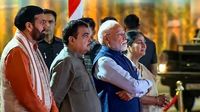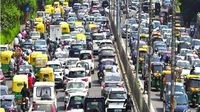On Sunday, August 17, 2025, the city of Delhi witnessed the inauguration of two transformative highway projects: the Delhi sections of the Urban Extension Road-II (UER-II) and the Dwarka Expressway. Unveiled by Prime Minister Narendra Modi at a public gathering in Rohini, these projects represent a monumental investment—nearly ₹11,000 crore—aimed at easing chronic traffic congestion and enhancing connectivity throughout the National Capital Region (NCR).
According to Hindustan Times, the event was attended by a high-profile roster, including Union Minister of Road Transport and Highways Nitin Gadkari, Delhi Chief Minister Rekha Gupta, and Haryana Chief Minister Nayab Singh Saini. The atmosphere was charged with optimism, as officials and the public alike anticipated the far-reaching impact of these new roadways.
The Urban Extension Road-II (UER-II), envisioned as Delhi’s third ring road, stretches 75.7 kilometers—54.21 km within Delhi and 21.5 km in Haryana. The Delhi segment alone cost ₹5,580 crore, while the total project cost is pegged at ₹6,445 crore. UER-II’s route snakes from Alipur through Bawana, Rohini, Mundka, Najafgarh, and Dwarka, finally reaching Dichaon Kalan. As reported by India Today, this corridor is designed to divert freight and heavy traffic away from the already gridlocked Inner and Outer Ring Roads, as well as notorious bottlenecks like Mukarba Chowk and Dhaula Kuan.
Prime Minister Modi, addressing the crowd, called Delhi “a shining example of the development taking place in the country,” emphasizing that the new highways would “ease travel, save time, and benefit farmers, traders, and millions of residents.” He highlighted that infrastructure in Delhi-NCR has become world-class over the last decade, with new projects like UER-II building on this momentum.
One notable aspect of UER-II’s construction is its environmental benefit. The project reused 1 million metric tonnes of inert waste from the Bhalswa and Ghazipur landfills—an innovative approach that not only supported road construction but also helped reduce Delhi’s infamous landfill mountains. According to officials cited by Times of India, this effort underscores a commitment to sustainability alongside urban expansion.
The UER-II corridor is more than just a bypass for city traffic. It will directly connect to outer Delhi areas such as Narela, Bawana, Mundka, and Najafgarh, and provide new links to Bahadurgarh and Sonipat. These connections are expected to boost industrial and freight movement, enabling faster and more efficient goods transport across the NCR. Delhi Chief Minister Rekha Gupta described the project as a “historic gift” for the city, noting its potential to reduce pollution, improve trade flows, and uplift the overall quality of life. “UER-II’s network will integrate with the Delhi-Jaipur National Highway, the KMP Expressway, and the Delhi-Mumbai Expressway, creating faster routes to Chandigarh, Punjab, Jammu & Kashmir, Jaipur, and even Mumbai,” she said.
Meanwhile, the Dwarka Expressway’s Delhi section, spanning 10.1 km and costing around ₹5,360 crore, was also inaugurated. This stretch is divided into two packages: 5.9 km from the Shiv Murti intersection to the Road Under Bridge at Dwarka Sector-21, and 4.2 km from Dwarka Sector-21 to the Delhi-Haryana border. The Haryana portion, about 19 km, was opened earlier in March 2024. The new expressway provides a direct bypass for the congested Delhi-Gurugram Expressway (NH-48) and offers faster access to Gurugram and the Yashobhoomi convention centre. Its features include a 5.1 km tunnel connecting to Indira Gandhi International (IGI) Airport, elevated stretches, and a four-level interchange—two of which are underground—offering multimodal connectivity with Delhi Metro’s Blue and Orange Lines, the upcoming Bijwasan railway station, and the Dwarka cluster bus depot.
Union Minister Nitin Gadkari praised the projects as a reflection of the Prime Minister’s vision to decongest the capital and provide high-speed connectivity across the NCR. “These projects will not just reduce travel time but also improve the standard of living for lakhs of people,” he said. Gadkari further stated that the new roadways, when combined with other packages, add up to a staggering 563 kilometers of upgraded infrastructure in the Delhi region. He estimated that these developments could reduce Delhi’s notorious traffic jams by as much as 50%.
The ripple effects of these projects extend beyond mere transportation. Hindustan Times reported that the UER-II and Dwarka Expressway will spur real estate development, especially along the new corridors. Data from market analysts shows that nearly 45,000 housing units have been launched along the Dwarka Expressway corridor over the past decade, with between 20,000 and 22,000 already completed. Sunil Sareen, deputy convener of the Dwarka Expressway Group Development Authority, remarked, “This will also bring world-class infrastructure to our doorstep. For residents, it means safer roads, better quality of life, and rising property values; for the region, it signals the start of a new era of growth and opportunity.”
The inauguration day itself was not without its challenges. The Delhi Traffic Police issued a detailed advisory, warning commuters of restrictions from 6 AM to 2 PM in Tikri Border, Peeragarhi, and Rohini. Commercial vehicles were banned on Rohtak Road between Tikri Border and Peeragarhi, while several other roads—including UER-II, Rohtak Road, and connecting stretches—remained closed or diverted. Commuters were urged to plan ahead, use alternative routes, or opt for Metro services to avoid inconvenience.
Despite the government’s positive framing, some transport experts have offered a note of caution. As highlighted by Times of India, while new highways can offer immediate relief, they sometimes shift bottlenecks rather than eliminating them. The true test, these experts suggest, will be whether the projects deliver sustained improvements as the city’s population and vehicle numbers continue to swell.
Nonetheless, for Delhi’s weary commuters, the opening of UER-II and the Dwarka Expressway marks a significant step toward a smoother, more connected future. The projects promise not just to cut travel times—by up to 60% from IGI Airport to parts of southwest and northwest Delhi—but also to integrate the capital more seamlessly with its neighboring states, industrial hubs, and the rest of India.
With the ribbon now cut and the roads open, Delhi stands at the cusp of a new era in urban mobility—one in which world-class infrastructure, environmental innovation, and regional connectivity come together to redefine the daily experience of millions.

